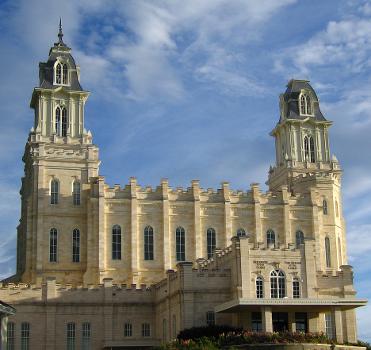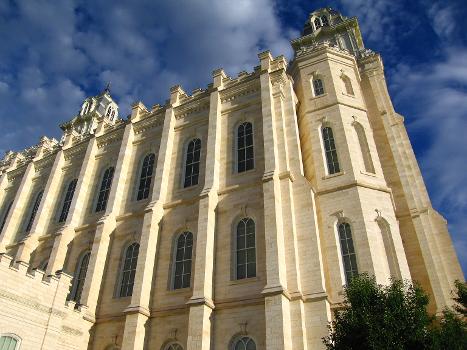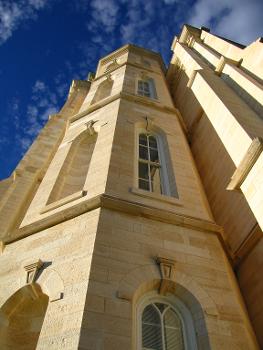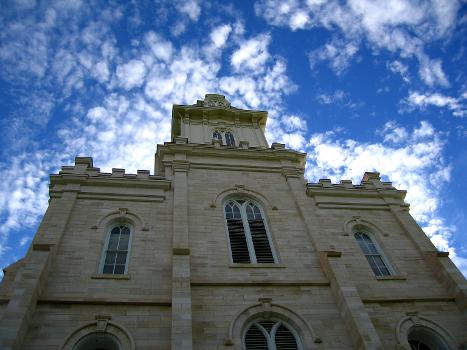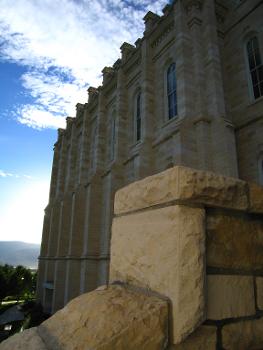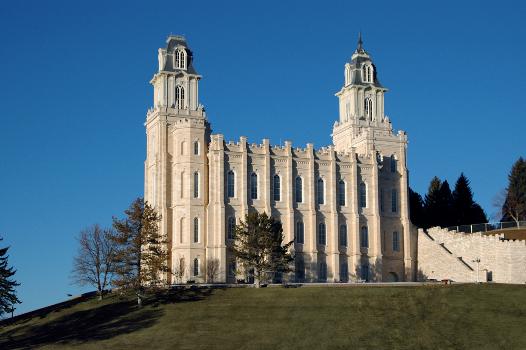General Information
| Completion: | 17 May 1888 |
|---|---|
| Status: | in use |
Project Type
| Function / usage: |
Church |
|---|---|
| Architectural style: |
Eclectic |
| Material: |
Masonry structure |
Location
| Location: |
Manti, Sanpete County, Utah, USA |
|---|---|
| Coordinates: | 39° 16' 22.46" N 111° 38' 2.08" W |
Technical Information
Dimensions
| height | 55 m | |
| site area | 10.9 ha | |
| gross floor area | 9 325 m² |
Excerpt from Wikipedia
The Manti Utah Temple (formerly the Manti Temple) is the fifth constructed temple of The Church of Jesus Christ of Latter-day Saints (LDS Church). Located in the city of Manti, Utah, it was the third LDS temple built west of the Mississippi River, after the Mormons' trek westward. (The St. George and Logan Utah temples preceded it.) The Manti Temple was designed by William Harrison Folsom, who moved to Manti while the temple was under construction. The temple dominates the Sanpete Valley, and can be seen from many miles. Like all LDS temples, only church members in good standing may enter. It is one of only two remaining LDS temples in the world where live actors are used in the endowment ceremonies (the other is the Salt Lake Temple); all other temples use films in the presentation of the endowment. It is an early pioneering example of four rooms representing the journey of life.
History
Brigham Young announced the decision to build an LDS temple in Manti on June 25, 1875, and dedicated the site on April 25, 1877. On the day of the dedication, Young took Warren S. Snow to the southeast corner of the temple site and told him, "Here is the spot where the Prophet Moroni stood and dedicated this piece of land for a Temple site, and that is the reason why the location is made here, and we can't move it from this spot."
The Salt Lake Temple had been announced in 1847, but construction was still underway and not finished until 1893. The Manti Temple was built, along with the St. George and Logan temples, to satisfy the church's immediate need for these structures. The site for the temple was the Manti Stone Quarry, a large hill immediately northeast of town. Early Mormon settlers in the area had prophesied that this would be the site of a temple. When Young announced the building of the temple, he also announced that the 27-acre (110,000 m²) plot would then be known as "Temple Hill."
The temple was completed in 1888, and a private dedication was held on May 17, 1888, with a prayer written by Wilford Woodruff. Three public dedications were held on May 21–23, 1888, and were directed by Lorenzo Snow.
The Manti Temple was the location of the Holy of Holies until the Salt Lake Temple was dedicated. The room was then used for sealings until it was closed in the late 1970s.
A 1966 study found that 52 percent of temple work was being done in either the Salt Lake, Logan, or Manti temples, even though there were 13 operating temples by that time. This led to the building of the Ogden and Provo temples to relieve the strain on the older pioneer-era temples.
Renovations
The Manti Temple has undergone various remodeling and renovations. Construction of a great stone stairway leading up the hill to the west temple doors began in 1907. In 1935, the temple was fully lit at night for the first time. In 1940 the stone stairs were removed and work began to beautify the grounds. Between 1944 and 1945 the annex, chapel, kitchen, Garden Room, and men's and women's areas were remodeled. There was once a tunnel beneath the east tower of the temple through which wagons and cars could pass, but it was closed off in the 1960s.
In 1981 church officials decided that the interior of the temple needed extensive remodeling. The renovation took four years, during which murals and original furniture were restored, offices were enlarged and remodeled, a separate door was made to the baptistry, water and weather damage were repaired, an elevator was installed, and locker rooms were improved among many other projects. In June 1985, Gordon B. Hinckley directed the rededication ceremonies. Exterior preservation efforts have also occurred since that time.
Style
The Manti Temple combines the Gothic Revival, French Renaissance Revival, Second French Empire, and Colonial architectural styles. The temple has 100,373 square feet (9,325 m²) of floor space, eight sealing rooms, four ordinance rooms, and a Celestial room. The exterior is made of fine-textured, cream-colored oolite limestone from quarries in the hill on which the temple now stands. The two towers of the temple are 179 feet (55 m) tall, and the open center spiral staircases inside the towers are marvels of pioneer ingenuity.
Text imported from Wikipedia article "Manti Utah Temple" and modified on November 9, 2020 according to the CC-BY-SA 4.0 International license.
Participants
- William Harrison Folsom (architect)
Relevant Web Sites
- About this
data sheet - Structure-ID
20025069 - Published on:
14/11/2006 - Last updated on:
08/11/2020


